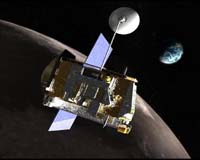 |
Sydney, Australia (SPX) Aug 20, 2009 For decades, microsatellites have been a boon to spaceflight. A small satellite can be built and launched fairly cheaply, sometimes hitching a ride for free aboard a large satellite launch. So far, microsatellites have not ventured very far into space. Could one go all the way to the Moon? Amateur groups have speculated on this possibility for years, but none have actually built a bird and sent it to the Moon. If spaceflight has to be done on the cheap in these budget-conscious times, do microsatellites have anything to offer? For some purposes, the answer is clearly no. Most scientific instruments are simply too large to be carried aboard a microsatellite. The instruments on board the Lunar Reconnaissance Orbiter, currently exploring the Moon, are generally larger than some microsatellites themselves. Add the requirements for power and data, and the need for a large spacecraft becomes obvious. Microsatellites are poor delivery platforms for landers and rovers, which are clearly in demand for the near future. But scientific instruments have been carried by microsatellites in Earth orbit, sometimes with outstanding results. Canada has launched a small space telescope that watches the wobbles on the surfaces of distant stars. The Moon has also been mapped and studied by the European SMART-1 spacecraft, which was fairly large for a microsatellite, but still a relatively small bird. Some of the instruments on SMART-1 were useful and compact. In theory, a microsatellite carrying a single small experiment could be sent to lunar orbit. It would probably fly to geostationary transfer orbit as a piggyback payload, then fire a small motor to send it to the Moon. Candidate instruments include radiation sensors and narrow-range spectrometers. Microsatellites could also serve as delivery systems for small impactors. Some of these could be targeted at suspected ice-bearing regions at the Moon's poles, delivering small instruments to sample the deposits in-situ. The production of a small fleet of microsatellites could allow the simultaneous measurement of particles and fields at different regions at the same time. It's worth exploring these ideas, even if they have taken longer to develop than we had hoped. Morris Jones is the author of "The New Moon Race", available from Rosenberg Publishing. Share This Article With Planet Earth
Related Links - Mars News and Information at MarsDaily.com Lunar Dreams and more
 The Ultimate Long Distance Communication
The Ultimate Long Distance CommunicationWhite Sands NM (SPX) Aug 20, 2009 Anyone who's vacationed in the mountains or lived on a farm knows that it's hard to get good internet access or a strong cell phone signal in a remote area. Communicating across great distances has always been a challenge. So when NASA engineers designed the Lunar Reconnaissance Orbiter (LRO), they knew it would need an extraordinary communications system. Over the next year, the LRO, NASA ... read more |
|
| The content herein, unless otherwise known to be public domain, are Copyright 1995-2009 - SpaceDaily. AFP and UPI Wire Stories are copyright Agence France-Presse and United Press International. ESA Portal Reports are copyright European Space Agency. All NASA sourced material is public domain. Additional copyrights may apply in whole or part to other bona fide parties. Advertising does not imply endorsement,agreement or approval of any opinions, statements or information provided by SpaceDaily on any Web page published or hosted by SpaceDaily. Privacy Statement |